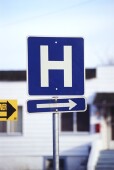- Navigating Your Midlife Crisis: Embracing New Possibilities
- City Raccoons Showing Signs of Domestication
- Mapping the Exposome: Science Broadens Focus to Environmental Disease Triggers
- One Week Less on Social Media Linked to Better Mental Health
- Your Brain Changes in Stages as You Age, Study Finds
- Some Suicide Victims Show No Typical Warning Signs, Study Finds
- ByHeart Formula Faces Lawsuits After Babies Sickened With Botulism
- Switch to Vegan Diet Could Cut Your Greenhouse Gas Emissions in Half
- Regular Bedtime Does Wonders for Blood Pressure
- Dining Alone Could Mean Worse Nutrition for Seniors
1 in 3 Americans Lives an Hour or More From a Stroke Center


One-third of Americans can’t be transported by ambulance to a stroke center within one hour, a new study reports.
Even under the best conditions, a large number of Americans would not be able to arrive at a stroke center within an hour because they live too far away, according to the study.
“Research has shown that specialized stroke care has the potential to reduce death and disability,” wrote study author Dr. Michael Mullen, from the University of Pennsylvania.
“Stroke is a time-critical disease. Each second after a stroke begins, brain cells die, so it is critically important that specialized stroke care be rapidly accessible to the population,” he explained.
Results of the study were published online March 4 in the journal Neurology.
Mullen and his colleagues examined data from 2010, when there were 811 primary stroke centers in the United States. Certification of comprehensive stroke centers — a higher level of classification — did not begin until 2012.
The researchers modeled what might happen if 20 ideally located primary stroke centers in each state were transformed into comprehensive stroke centers. This change would mean that 63 percent of Americans would live within a one-hour drive, and another 23 percent would be within a one-hour flight of a center.
However, they also found significant regional variations, with access to a stroke center lowest in the southeastern United States, an area often referred to as the Stroke Belt because of the high rate of stroke incidence there.
“There are geographic differences in stroke incidence, especially in rural areas and in the Stroke Belt,” Mullen said in a journal news release. “Reduced access to specialized stroke care in these areas has the potential to worsen these disparities. This emphasizes the need for oversight of developing systems of care.”
Modeling studies such as this could help health planners and policy makers identify areas of need and take steps to ensure that timely access to stroke care is available across the United States, Mullen said.
More information
The U.S. National Heart, Lung, and Blood Institute has more about stroke.
Source: HealthDay
Copyright © 2025 HealthDay. All rights reserved.










